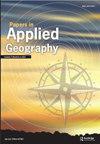Comparing Drone-Derived Elevation Data with Air-Borne LiDAR to Analyze Coastal Sea Level Rise at the Local Level
Q2 Social Sciences
引用次数: 4
Abstract
Abstract Sea level rise is a coastal hazard leading to erosion, flooding, and habitat destruction among other effects. Geoinformatics plays a vital role in providing tools to assess coastal vulnerability. Recent improvements in drone technology offer new opportunities for collecting data. Calibrating drone elevation data to local sea-levels is a current challenge. This research compares the use of drone-derived digital elevation models (DEMs) created from a DJI Phantom 4 Pro drone with airborne LiDAR data to analyze sea-level rise in Essex, Massachusetts. To evaluate the best method of calibrating drone elevation data to the local environment, three different Ground Control Point (GCP) methods were evaluated: surveyed GCPs, LiDAR-derived GCPs, and the NAVD88 sea-level (0-value) of the LiDAR data. The three drone-derived DEMs were compared with a LiDAR DEM through two methods: 1) comparing how well the DEMs measured the elevation of surveyed GCPs, and 2) how well the DEMs modeled five different scenarios of sea level rise compared with a LiDAR DEM. Results showed that two of the calibration methods performed well; the surveyed GCP derived drone DEM and the LiDAR NAVD88 sea-level (0-value) derived drone DEM.比较无人机获得的高程数据与机载激光雷达在局部水平分析沿海海平面上升
海平面上升是一种沿海灾害,会导致侵蚀、洪水和栖息地破坏等影响。地理信息学在提供评估沿海脆弱性的工具方面发挥着至关重要的作用。最近无人机技术的改进为收集数据提供了新的机会。将无人机的高程数据与当地海平面进行校准是当前的一个挑战。这项研究比较了大疆Phantom 4 Pro无人机生成的无人机数字高程模型(dem)与机载激光雷达数据的使用,以分析马萨诸塞州埃塞克斯的海平面上升情况。为了评估将无人机高程数据校准到当地环境的最佳方法,我们评估了三种不同的地面控制点(GCP)方法:调查GCP、LiDAR衍生GCP和LiDAR数据的NAVD88海平面(0值)。通过两种方法将三个无人机衍生的DEM与LiDAR DEM进行比较:1)比较DEM测量被调查gcp高程的效果;2)与LiDAR DEM相比,DEM模拟海平面上升的五种不同情景的效果。结果表明,两种方法均具有较好的标定效果;实测GCP衍生无人机DEM和LiDAR NAVD88海平面(0值)衍生无人机DEM。
本文章由计算机程序翻译,如有差异,请以英文原文为准。
求助全文
约1分钟内获得全文
求助全文

 求助内容:
求助内容: 应助结果提醒方式:
应助结果提醒方式:


